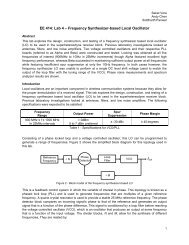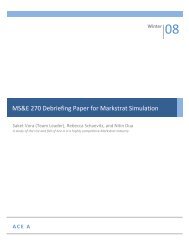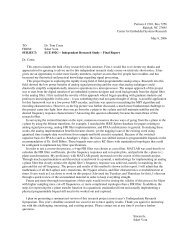Copernicus and the Revolutionibus The publication of ... - Saket Vora
Copernicus and the Revolutionibus The publication of ... - Saket Vora
Copernicus and the Revolutionibus The publication of ... - Saket Vora
You also want an ePaper? Increase the reach of your titles
YUMPU automatically turns print PDFs into web optimized ePapers that Google loves.
<strong>Saket</strong> <strong>Vora</strong>HI 322 Sec. 001August 29, 2006Dr. Kimler<strong>Copernicus</strong> <strong>and</strong> <strong>the</strong> <strong>Revolutionibus</strong><strong>The</strong> <strong>publication</strong> <strong>of</strong> <strong>the</strong> <strong>Revolutionibus</strong> Orbium Coelestium (On <strong>the</strong> Revolutions <strong>of</strong> <strong>the</strong>Heavenly Spheres) by Nicholas <strong>Copernicus</strong> was a crucial step in a long chain <strong>of</strong> events that set intomotion <strong>the</strong> ‘scientific revolution’ <strong>of</strong> <strong>the</strong> 17 th century. It was <strong>the</strong> first work to seriously re-introduce<strong>the</strong> notion <strong>of</strong> heliocentrism to scholarly debate in Europe, inspiring future learned men such asGalileo Galilei <strong>and</strong> Johannes Kepler to carry on <strong>and</strong> exp<strong>and</strong> <strong>the</strong> <strong>the</strong>ory. <strong>The</strong> role <strong>of</strong> <strong>the</strong><strong>Revolutionibus</strong> is not that <strong>of</strong> a brazen opening salvo against <strong>the</strong> Ptolemaic system, but instead adelicate push towards physically freeing <strong>the</strong> Earth from its rigidly stationary place in <strong>the</strong> cosmos.This paper explores <strong>the</strong> motivations <strong>of</strong> <strong>Copernicus</strong> to write his <strong>Revolutionibus</strong> <strong>and</strong> <strong>the</strong> justificationshe states for affirming his <strong>the</strong>ory.To underst<strong>and</strong> what propelled <strong>Copernicus</strong> to a new <strong>the</strong>ory one must underst<strong>and</strong> <strong>the</strong> context <strong>of</strong>his times. Since <strong>the</strong> 2 nd century CE, <strong>the</strong> system <strong>of</strong> <strong>the</strong> world proposed by Ptolemy in <strong>The</strong> Almagestwas <strong>the</strong> established description <strong>of</strong> <strong>the</strong> heavens, in no small part due to its acceptance by <strong>the</strong> CatholicChurch which was Europe’s primary political, religious, <strong>and</strong> scholastic institution throughout <strong>the</strong>medieval period. This system was firmly grounded in <strong>the</strong> logic <strong>of</strong> Aristotle <strong>and</strong> o<strong>the</strong>r Greekphilosophers, with an emphasis on <strong>the</strong> heavens’ unchanging cosmic order <strong>and</strong> perfection. 1 Itconsisted <strong>of</strong> an unmoving Earth at <strong>the</strong> center <strong>of</strong> <strong>the</strong> Universe, surrounded by spinning concentriccrystalline spherical shells which contained <strong>the</strong> celestial bodies with a fixed outer shell containing <strong>the</strong>starry field. <strong>The</strong> Sun occupied <strong>the</strong> shell between Venus <strong>and</strong> Mars. 2 Ptolemy’s model was able topredict <strong>the</strong> motions <strong>of</strong> <strong>the</strong> sun, moon, <strong>and</strong> planets well enough at <strong>the</strong> time to be used to create acalendar. Thirteen centuries later however, <strong>the</strong> inaccuracies inherent in <strong>the</strong> model <strong>and</strong> expressed via<strong>the</strong> calendar were becoming too apparent to ignore. <strong>The</strong> dates on which to celebrate Easter <strong>and</strong> o<strong>the</strong>r1
eligious days, which had historical seasonal or astronomical significance, were deemed suspect <strong>and</strong><strong>the</strong>re were several efforts by <strong>the</strong> Vatican to reform <strong>the</strong> calendar. <strong>Copernicus</strong> was invited to one <strong>of</strong><strong>the</strong>se reform councils in 1514, so <strong>the</strong> inaccuracies <strong>of</strong> <strong>the</strong> prevailing model in predicting planetarymotion were known to him. 3 <strong>Copernicus</strong>, by this time a skilled ma<strong>the</strong>matician, was aware <strong>of</strong> not onlyPtolemy’s original model, but a multitude <strong>of</strong> variations <strong>of</strong> it that astronomers over <strong>the</strong> yearsintroduced as knowledge from Arab scholars more observational data (not always accurate) becameavailable. Observational data was also unsatisfactory, as <strong>Copernicus</strong> notes that even <strong>the</strong> length <strong>of</strong> acomplete year has not been precisely measured. 4 In <strong>the</strong> preface <strong>of</strong> <strong>the</strong> <strong>Revolutionibus</strong> addressed toPope Paul III, he briefly states several models <strong>and</strong> <strong>the</strong>ir flaws, such as inconsistent uses <strong>of</strong> eccentrics<strong>and</strong> concentrics as well as uses <strong>of</strong> eccentrics <strong>and</strong> equants that violate <strong>the</strong> Aristotelian principle <strong>of</strong> <strong>the</strong>uniformity <strong>of</strong> motion. <strong>Copernicus</strong> “began to grow disgusted that no more consistent scheme <strong>of</strong> <strong>the</strong>movements <strong>of</strong> <strong>the</strong> mechanism <strong>of</strong> <strong>the</strong> universe, set up for our benefit by that best <strong>and</strong> most lawabiding Architect <strong>of</strong> all things, was agreed upon by philosophers.” 5 Thus, <strong>the</strong> primary motivation for<strong>Copernicus</strong> to formulate <strong>and</strong> present a new <strong>the</strong>ory was to “solve <strong>the</strong> problem <strong>of</strong> <strong>the</strong> planets.” 6 He wasencouraged by his colleagues <strong>and</strong> friends to publish his work <strong>and</strong> says to <strong>the</strong> Pope that he might“contribute something to <strong>the</strong> ecclesiastical state whose chief <strong>of</strong>fice Your Holiness now occupies.” 7<strong>The</strong> remainder <strong>of</strong> <strong>the</strong> preface <strong>and</strong> books <strong>of</strong> <strong>the</strong> <strong>Revolutionibus</strong> is devoted to providing historical,logical, <strong>and</strong> ma<strong>the</strong>matical justifications for his <strong>the</strong>ory.<strong>Copernicus</strong> began his investigation by studying <strong>the</strong> works <strong>of</strong> all <strong>the</strong> philosophers who haveopinionated on a structure <strong>of</strong> <strong>the</strong> Universe that differed from <strong>the</strong> view taught by current scholars. Inparticular, <strong>Copernicus</strong> mentions Niceta <strong>of</strong> Syracuse, Philolaus <strong>the</strong> Pythagorean, Heraklides <strong>of</strong> Pontus,<strong>and</strong> Ekphantus <strong>the</strong> Pythagorean as ones who postulated <strong>the</strong> movement <strong>of</strong> <strong>the</strong> Earth. 8 It is nocoincidence that <strong>the</strong>se philosophers were <strong>of</strong> <strong>the</strong> ancient world, living in <strong>the</strong> 5 th <strong>and</strong> 4 th century B.C.Contemporary European scholastic learning <strong>and</strong> even <strong>the</strong> very idea <strong>of</strong> what constituted ‘knowledge’had its roots in <strong>the</strong> ancient world, built upon <strong>the</strong> foundation <strong>of</strong> Socrates, Plato, <strong>and</strong> Aristotle. 9 To lend2
greater credibility to his <strong>the</strong>ory, <strong>Copernicus</strong> looked towards <strong>the</strong> contemporaries <strong>of</strong> Plato <strong>and</strong> Aristotle<strong>and</strong> showed that even <strong>the</strong> venerable ancients were not in agreement about <strong>the</strong> Earth’s movement.Beginning his defense with this observation, <strong>Copernicus</strong> both denies his critics a quick way todiscredit <strong>the</strong> basis for his <strong>the</strong>ory <strong>and</strong> distances himself from being a true maverick; he is not <strong>the</strong>originator <strong>of</strong> <strong>the</strong> moving Earth <strong>the</strong>ory, but is simply building upon an existing but long discardedidea. <strong>The</strong> second argument he provides stems from Aristotelian logic, namely a return to <strong>the</strong> principal<strong>of</strong> uniform circular motion that <strong>the</strong> perfect <strong>and</strong> pure heavens surely adhered to. It had been longknown that <strong>the</strong> planets did not appear to have <strong>the</strong> same regular motion as <strong>the</strong> moon, <strong>the</strong> sun, or <strong>the</strong>stars. Planets would vary in <strong>the</strong> size <strong>of</strong> <strong>the</strong>ir appearance <strong>and</strong> even stranger, some would even appearto go backwards for a period <strong>of</strong> time before continuing on its usual course. Ptolemy introduced <strong>the</strong>epicycle to fix this, but in order for <strong>the</strong> ma<strong>the</strong>matics to work he did not center <strong>the</strong> epicycle’s orbit <strong>of</strong>revolution with that <strong>of</strong> <strong>the</strong> Earth, but <strong>of</strong> a point between <strong>the</strong> Earth <strong>and</strong> that orbit’s equant. <strong>The</strong> equantwas <strong>the</strong> point <strong>of</strong> reference that <strong>the</strong> planet maintained uniform circular motion. To complicate thisfur<strong>the</strong>r, celestial bodies used different equants <strong>and</strong> epicycles. While <strong>the</strong> ma<strong>the</strong>matics for this will notbe delved into here, <strong>Copernicus</strong> demonstrated that an unavoidable consequence <strong>of</strong> using equants was<strong>the</strong> non-uniform motion <strong>of</strong> <strong>the</strong> spheres. 10 Thus, <strong>Copernicus</strong> attempts to appeal to his critics’Aristotelian sensibilities in trying to show that his <strong>the</strong>ory actually adheres to Aristotle’s logic <strong>and</strong>order <strong>of</strong> <strong>the</strong> cosmos better than Ptolemy’s. Later in <strong>the</strong> preface, after explicitly stating his order <strong>of</strong> <strong>the</strong>planets in a heliocentric universe, <strong>Copernicus</strong> says that “in this arrangement…we discover amarvelous symmetry <strong>of</strong> <strong>the</strong> universe, <strong>and</strong> an established harmonious linkage between <strong>the</strong> motion <strong>of</strong><strong>the</strong> spheres <strong>and</strong> <strong>the</strong>ir size, such as can be found in no o<strong>the</strong>r way.” 11 Once again, <strong>Copernicus</strong>emphasizes how his <strong>the</strong>ory preserves <strong>the</strong> ancient belief <strong>of</strong> inherent beauty <strong>and</strong> symmetry that <strong>the</strong>cosmos was thought to physically display. A <strong>the</strong>ory for <strong>the</strong> universe could now both bema<strong>the</strong>matically accurate <strong>and</strong> physically convincing. What about <strong>the</strong> specific motion <strong>of</strong> <strong>the</strong> Earth?Here <strong>Copernicus</strong> returns to <strong>the</strong> primary purpose for exploring <strong>the</strong> topic – to solve <strong>the</strong> problem <strong>of</strong> <strong>the</strong>3
planets. Though <strong>the</strong> ma<strong>the</strong>matics are found in later sections, <strong>Copernicus</strong> shows that <strong>the</strong> backwards<strong>and</strong> forward motions <strong>of</strong> <strong>the</strong> planets <strong>and</strong> <strong>the</strong> variation in observed size all “proceed from <strong>the</strong> samecause, which is <strong>the</strong> Earth’s motion.” 12 <strong>The</strong> real advancement <strong>of</strong> <strong>Copernicus</strong> was to use ma<strong>the</strong>maticsto demonstrate that <strong>the</strong> planetary phenomena were due to apparent movement as observed from amoving Earth. 13 Fur<strong>the</strong>rmore, not only did his <strong>the</strong>ory predict <strong>the</strong> motions <strong>of</strong> <strong>the</strong> celestial bodies justas well as Ptolemaic models, but it <strong>of</strong>fered a physical basis for <strong>the</strong>se predictions in a manner thatqualitatively appeared more symmetric <strong>and</strong> orderly.Ultimately, <strong>the</strong> full exposition <strong>of</strong> <strong>the</strong> Copernican model proved unconvincingly simpler ormore practical than <strong>the</strong> Ptolemaic models. Despite this outcome, <strong>Copernicus</strong> was successful indemonstrating that a moving Earth model for <strong>the</strong> universe showed promise in solving <strong>the</strong> problem <strong>of</strong><strong>the</strong> planets – an achievement seen in <strong>the</strong> works <strong>of</strong> future astronomers. Encouraged by his colleagues<strong>and</strong> from a desire to bring cohesion <strong>and</strong> order to a multitude <strong>of</strong> varying <strong>the</strong>ories, <strong>Copernicus</strong>presented a new <strong>the</strong>ory that was supported by historical inquiry <strong>of</strong> ancient philosophers, grounded in<strong>the</strong> logic <strong>and</strong> principles <strong>of</strong> Aristotle, <strong>and</strong> ma<strong>the</strong>matics that demonstrated <strong>the</strong> practical advantages thata moving earth had in physically explaining planetary observations. <strong>The</strong> <strong>Revolutionibus</strong> served as acrucial transitional work that eased <strong>the</strong> acceptance <strong>of</strong> heliocentrism in Europe, <strong>and</strong> for that<strong>Copernicus</strong> is duly remembered.4
Works Cited1. Kimler, William. 28 Aug. 2006, 30 Aug. 2006, 1 Sept. 2006. “Lectures on <strong>the</strong> Rise <strong>of</strong> ModernScience,” Raleigh: North Carolina State University.2. Kuhn, Thomas. <strong>The</strong> Copernican Revolution: Planetary Astronomy in <strong>the</strong> Development <strong>of</strong> WesternThought. Harvard University Press, Massachusetts. © 1957, pg. 53.3. Kusukawa, Sachiko <strong>and</strong> Liba Taub, et al, editors. “<strong>Copernicus</strong> <strong>and</strong> Calendar Reform”. StarryMessenger Project. Department <strong>of</strong> History <strong>and</strong> Philosophy <strong>of</strong> Science <strong>of</strong> <strong>the</strong> University <strong>of</strong>Cambridge. URL: http://www.hps.cam.ac.uk/starry/copercalen.html © 1999-2000.4. <strong>Copernicus</strong>, Nicholas. On <strong>the</strong> Revolutions <strong>of</strong> <strong>the</strong> Heavenly Spheres, Preface. Translated <strong>and</strong> reprinted.Hosted online by William Kimler. URL:http://legacy.ncsu.edu/classes/hi322001/derevpre.htm © 2005 (1543 original Latin)5. <strong>Copernicus</strong>, <strong>the</strong> Revolutions <strong>of</strong> <strong>the</strong> Heavenly Spheres, Preface.6. Kuhn, <strong>The</strong> Copernican Revolution, pg. 136.7. <strong>Copernicus</strong>, <strong>the</strong> Revolutions <strong>of</strong> <strong>the</strong> Heavenly Spheres, Preface.8. <strong>Copernicus</strong>, <strong>the</strong> Revolutions <strong>of</strong> <strong>the</strong> Heavenly Spheres, Preface.9. Kimler, “Lectures on <strong>the</strong> Rise <strong>of</strong> Modern Science.”10. Kuhn, <strong>The</strong> Copernican Revolution, pg. 148.11. <strong>Copernicus</strong>, <strong>the</strong> Revolutions <strong>of</strong> <strong>the</strong> Heavenly Spheres, Preface.12. <strong>Copernicus</strong>, <strong>the</strong> Revolutions <strong>of</strong> <strong>the</strong> Heavenly Spheres, Preface.13. Kuhn, <strong>The</strong> Copernican Revolution, pg. 150.Works ConsultedStimson, Dorothy. <strong>The</strong> Gradual Acceptance <strong>of</strong> <strong>the</strong> Copernican <strong>The</strong>ory <strong>of</strong> <strong>the</strong> Universe. Peter Smith,Gloucester, MA. © 1972 (1917 original)Vollmann, William T. Uncentering <strong>the</strong> Earth. Atlas Books. W. W. Norton & Company, New York,NY. © 20065









